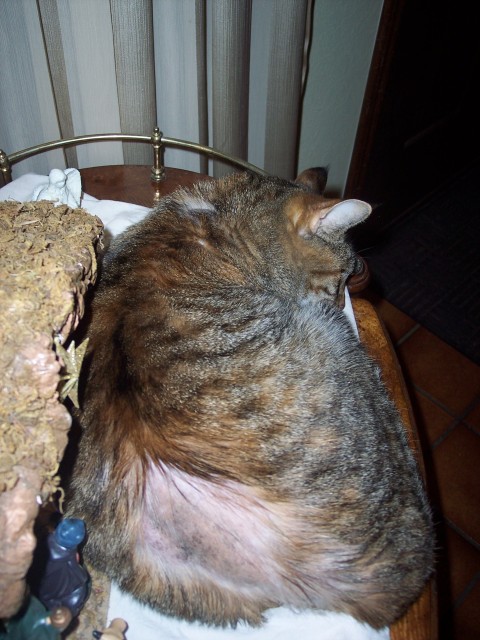QuestionI have a 16-year-old cat who has had chronic rhinitis for several years now. His nasal discharge has been cultured, and he has been tried on several antibiotics; but all to no avail. He tests negative for leukemia, etc. My vet suspects this could actually be a fungal infection and he mentioned that a sinus irrigation MIGHT be helpful. However, he does not recommend the procedure because of the cat's age. Meanwhile, the cat has more and more difficulty breathing because of the increased congestion, and he is now forced to breathe through his mouth. Do you have any suggestions for ways to help this cat breathe more comfortably? I truly appreciate any help you might offer.
AnswerChronic sinusitis often responds to the human antibiotic Zithromax...the dose is 1/4 of a 250mg tablet for a 7 pound cat (if the cat is 10-12 pounds I would just give 1/2 tab) once weekly--many times 2 doses will do it.
I don't think I would vote for the irrigation...I would go to an internal medicine specialist for a scoping procedure of the sinuses and then if necessary, they could scrape or flush the sinuses.
The other thing to consider is Transfer Factor to help stimulate his immune system. http://66.114.103.99/products/AnimalHealth/feline.html
available to order online at www.my4life.com/drfry
HERE IS INFO FOR YOUR VET ON ZITHROMAX.....
Zithromax - The Modern Treatment of Feline Chlamydia
By Dr David Richardson
Ragajac Ragdoll Cattery
Chlamydia is a relatively newly discovered bacteria, which causes serious problems in many species of animal as well as humans. In Australia, chlamydia has found its way into koala populations where it is a major cause of reduced fertility and declining populations. In kangaroos it causes blindness resulting in unfortunate animals hopping full force into trees and other solid objects resulting in stress, difficulty feeding and ultimate death. In humans chlamydia is responsible for the sexually transmitted "NSU" - Non Specific Urethritis, which causes pain on urination and a penile discharge in males and may cause scarring of the fallopian tubes and infertility in women who may have no symptoms until they try to become pregnant.
In many species, including felines and humans Chlamydis is a common cause of Respiratory Tract Infections - 'RTI', and Upper Respiratory Tract Infections - 'URTI'.URTIs cause nasal congestion and discharge and in cats runny eyes. RTIs affect the lungs and may cause pneumonia.
Chlamydia was only relatively recently discovered, because it is a difficult organism to culture in laboratories, and difficult to see under the microscope. It responds poorly to most common antibiotics and until recently the best medical treatment was a long course ( 4 weeks) of vibramycin, (Vibravet) - a tetracycline based antibiotic.
In cats Chlamydia is very common and a major health problem for breeders. It causes a flu like illness with sneezing, serous (clear) discharge from the nose and runny eyes. Some prominent Persian breeders feel that chlamydia may be endemic in some catteries and is a contributing causes to the chronic runny eyes in their cats.
I feel chlamydia is also a common cause of pneumonia in young kittens. Many of us have had kittens who seemed well until about two weeks then became ill , stopped feeding developed a rattly chest and eventually died. This is probably chlamydial pneumonia. It may well be one of the causes of Fading Kitten Syndrome which may affect kittens as young as 24 hrs on.
Zithromax is a new , safe antibiotic which is highly effective against chlamydia. Vibravet takes four weeks to wipe out Chlamydia; Zithromax does it in a single dose.
Many vets will not have heard of Zithromax, which may have not been promoted to them as an animal drug. However it is very safe and it works well.
DOSAGE: The dose of Zithromax for cats in 20mg Zithromax per kg body weight.
It is available in a syrup, with 600mg of Zithromax in 15mls. The dos for an average three kg adult cat would be 3 times 20mg = 60mg or 1.5mls of syrup.
It is also available in 250 mg and 500mg tablets. The dose for an average 3kg cat would be 1/4 of a 250mg tablet - or 1/8 of a 500mg tablet.
USE OF ZITHROMAX IN BREEDING CATTERIES
Entire Cattery Populations - If you have many problems with respiratory infections, runny eyes and noses and sneezing ask your vet to do a culture for chlamydia. If it is positive I would advocate treating the whole cattery.
New Cats - If you are buying a new breeder and you have little knowledge of the breeding cattery or cannot inspect it because it is interstate or distant I would advocate treating the new breeder with a single dose of Zithromax before introducing the cat to your resident population.
Pregnant Queens - It would seem that chlamydia can exist in cats in a dormant form, and that some resistance is given to kittens by maternal antibodies which fade out at about 2 weeks after birth, which is when many kittens will get sick, develop pneumonia and die. If you have any suspicion your pregnant queen may have, have had, or have been exposed to chlamydia (this probably includes most queens), I advocate giving a single dose of 20mg/kg of Zithromax on about the 58th day of pregnancy. At this stage there is no risk to the unborn kittens, who may otherwise contract chlamydia from the queen during birth or soon after.
I feel that if this became a standard cattery practice kitten losses may well be significantly reduced.
SUMMARY...Zithromax is a new and highly effective and safe single dose treatment for chlamydia. Though not widely known by vets it is has wide applications in breeding catteries and may well help cure many chronic health problems as well as if given to pregnant queens on the 58th day, may help prevent losses of newly born and young kittens. The dose is 20mg/kg bodyweight of cat. Dr David Richardson -23/6/99
Since writing this article I have received feed back from some catteries that the single dose quietens down the symptoms in badly affected cats, but they may recur in a few weeks.
Zithromax remains at an effective concentration within the tissues for a week, thus giving a single dose is like giving a seven day course of a shorter lived antibiotic. Fore severely affected cats, and cats that have been symptomatic for weeks or months, or catteries where virtually the whole population is symptomatic I now suggest repeating the 20mg/kg dose seven days after the initial dose. In these badly or chronically affected catteries I must emphasize the treating of the WHOLE CAT POPULATION, including domestics and household pets and any other animals that the cats may have contact with to eliminate non symptomatic carriers of chlamydia. At the same time as treating Nuke the catteries with bleach at least twice within the week.
If the disease returns after this consider whether there may be a human carrier, yourself perhaps or family or staff. Consult you doctor before treating humans!
However one dose is sufficient as prophylaxis in pregnant queens, and in chlamydia affected cats if the symptoms are mild and when given early in the course of the illness. Dr David Richardson -16/10/99
ZITHROMAX USE IN DOGS AND CATS
Lou Gotthelf DVM
Author of "Small Animal Ear Diseases: An Illustrated Guide" by Saunders
1. In the fight against bacterial ear disease, many practitioners want a good systemic antibiotic to choose. Many prescribe a fluoroquinolone such as Baytril (Bayer) or Orbax (Schering-Plough) or even Zenequin (Pfizer).
For non-Pseudomoans ear disease in dogs and cats, I sometimes use a new antibiotic called Zithromax (Pfizer). It is a macrolide antibiotic very closely related to erythromycin with some major differences. First, Zithromax does not cause the GI side effects see with erythromycin. Second, it has a very long half-life and can be given every other day in the cat and every 3rd day in the dog. And third, it is an intracellular antibiotic. It has a low serum level, but a very high tissue level. It is found in high concentrations in neutrophils, so it can be delivered into a site of inflammation readily.
It is indicated for infections caused by Staph, Strep, and many gram negative infections. In addition it is indicated for many intracellular organisms such as Chlamydia and Mycoplasma, and has a bactericidal effect against Bordetella.
It is used in dogs for Staphylococci skin infections at a dose of 5mg/lb. every three days. Zithromax tablets contain 250mg of azithromycin so one tablet every 3 days will treat a Staph. pyoderma.
For cats with suspected Chlamydia or otitis, pediatric Zithromax suspension is available which contains either 600mg or 1200 mg azithromycin. Small aliquots of 80mg of the dry powder can be pre made. When ready for use 1 1/2 cc of sterile water is added to make 2cc of zithromax. Then 1cc per 8lbs. is given for 2 doses.
Many cases of bacterial otitis and pyoderma will resolve when Zithromax is used as the antibiotic. It has become my treatment of choice for chronic snuffling cats. It is especially useful for the hard to treat patient because it can be given infrequently.

 Cat Scabs and Hair Loss
Question
Scab Scab Again
My family just ad
Cat Scabs and Hair Loss
Question
Scab Scab Again
My family just ad
 Baby Kitty
Question
Baby Kitty
Our sweet Baby Kitty just turned 1
Baby Kitty
Question
Baby Kitty
Our sweet Baby Kitty just turned 1
 Possible Deaf Puppy.
Question
Paloma (white dove)
I have a 9 week old
Possible Deaf Puppy.
Question
Paloma (white dove)
I have a 9 week old
 Skin and Coat Issue
Question
Lulu rash
Hello Jana,
I realize from
Skin and Coat Issue
Question
Lulu rash
Hello Jana,
I realize from
 skin disease/hair loss
Question
hair loss area
We have a cat whose had a 1 inc
skin disease/hair loss
Question
hair loss area
We have a cat whose had a 1 inc